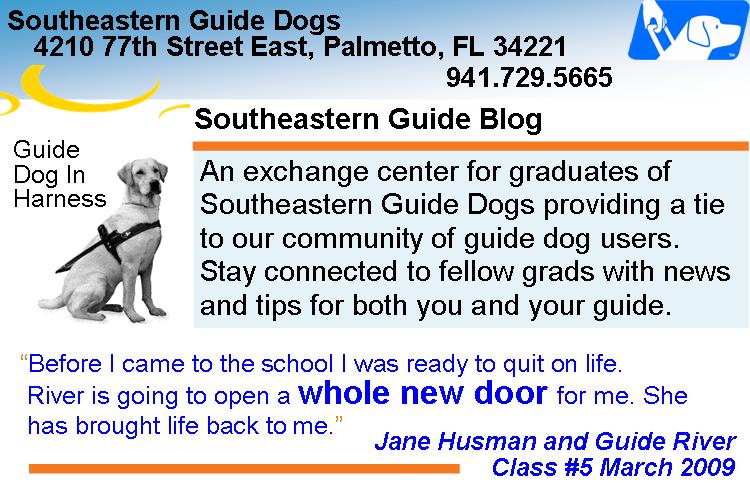TRAVEL TIPS
Packing for your Guide Dog when flying
By Bob Smallwood
It is always helpful to have friends or family with you when you travel. Then there are the times when you need to fly by yourself on a business or pleasure trip, so be prepared and do not hesitate to ask for help. I fly with my guide dog many times throughout the year on business and want to share some of my experiences that may help you.
Before you go, plan your packing. Just as you sort your things for the carry on and checked luggage, do the same for your dog. First thing I do is put each day’s meal for my dog in separate sealable baggies. I then add any daily supplements that he gets with each meal into those baggies. Packing individual meals this way is not only convenient but lets you fill in all those little empty spaces in your luggage.
In my carry on, for my dog, I pack two days meals, small or collapsible water bowl (dogs get easily dehydrated when flying), any medications, treats, waste cleanup bags, proof of rabies or other shots required when traveling out of country, and a small first aid kit. Sometimes checked luggage gets lost and this gives me time to replace missing items for my dog.
In my checked luggage goes the remainder of his food, a bowl for water and one for his food, more treats, more cleanup bags, his favorite toy, a dog comb or brush, and a sweater if traveling in the cold weather. I also pack my white cane in case of an emergency or injury of my dog.
In my experience, it is best not to feed my dog, Skye, for at least 12 hours before flying. On long flights, this means we are not looking for relief areas during what might be a short layover. I do feed Skye when we arrive at our destination.
This helps us both in making the trip easier and more pleasurable. So plan ahead. It only takes minutes and may save hours.
Flying with your Guide Dog
By Bob Smallwood
Now I am packed, have taken my dog for a walk, and ready to leave for the airport. When going to the airport in a taxi or by other means, I get dropped off at curbside check in if possible. Curbside check in has shorter lines and they can get you a skycap to escort you to the gate. The skycap will get you and your dog quickly through security. One caution, skycaps tend to move rapidly. If they walk too fast for you or your dog, make them slow down.
At the security checkpoint, make sure to have your I.D. and ticket easily accessible. Place items like your belt, cell phone, Keys, coins, or any other metal objects into your carry on. I have a small zippered bag that clips to my luggage for these items. This makes it easier as you or your assistant will not need to search through several containers to make sure you have everything.
When you get to the gate, confirm that you will have an escort onto the plane. If traveling alone, have the skycap seat you and explain where the counter and gate personnel are if you need help. Do not forget to tip the skycap. If I am on a long flight and at a layover gate when my dog needs to go out for a walk, I ask the gate personnel for help. They have always been helpful. If no relief area was near the gate, they have on occasion escorted us out onto the tarmac for my dog to relieve himself.
Upon boarding the plane, with a cabin Stewart escorting us, I remove my dogs harness in order to make it easier for both of us to maneuver down the aisle and get seated. My dog, who weighs 90 pounds, then tucks himself under the seat in front of me. If on a long flight, remember to get the water bowl out of your carry on and ask the Stewart for a bottle of water for your dog. The planes air may make your dog quickly dehydrated. Now sit back and relax.
Before disembarking from the plane, if at a layover or final destination, confirm with the cabin Stewart that an escort or skycap will meet you at the gate to get you where you need to be. Planning ahead and asking for help will ensure that your travel is less stressful both for you and your dog.
